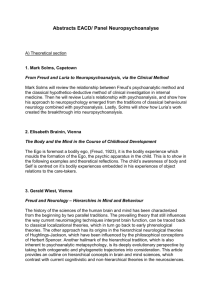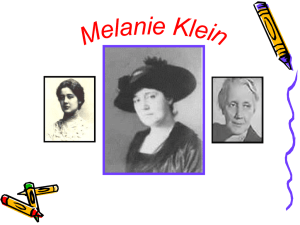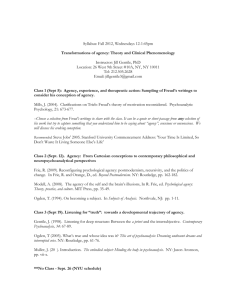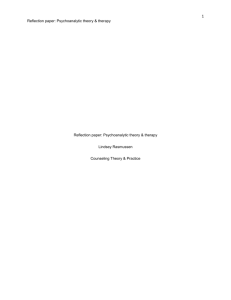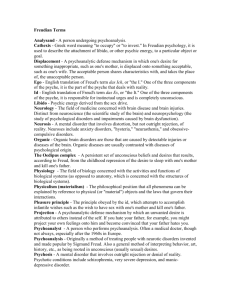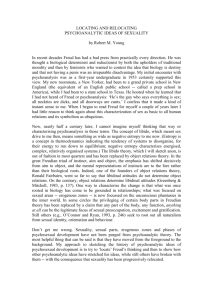Psychoanalytic Theories of Development
advertisement
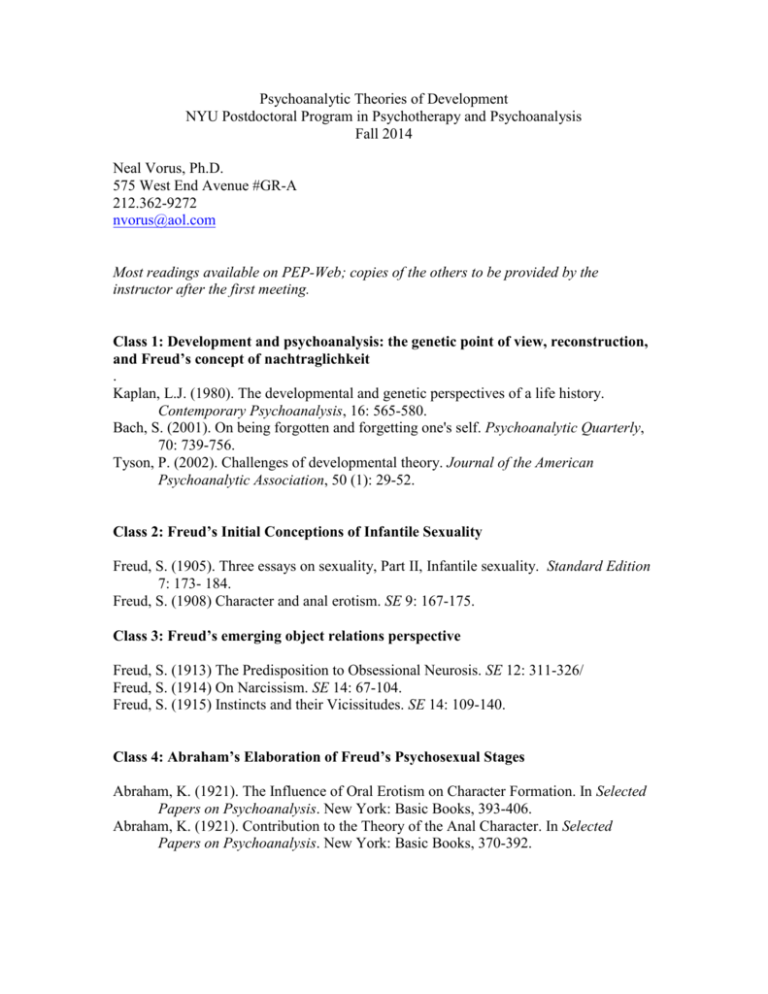
Psychoanalytic Theories of Development NYU Postdoctoral Program in Psychotherapy and Psychoanalysis Fall 2014 Neal Vorus, Ph.D. 575 West End Avenue #GR-A 212.362-9272 nvorus@aol.com Most readings available on PEP-Web; copies of the others to be provided by the instructor after the first meeting. Class 1: Development and psychoanalysis: the genetic point of view, reconstruction, and Freud’s concept of nachtraglichkeit . Kaplan, L.J. (1980). The developmental and genetic perspectives of a life history. Contemporary Psychoanalysis, 16: 565-580. Bach, S. (2001). On being forgotten and forgetting one's self. Psychoanalytic Quarterly, 70: 739-756. Tyson, P. (2002). Challenges of developmental theory. Journal of the American Psychoanalytic Association, 50 (1): 29-52. Class 2: Freud’s Initial Conceptions of Infantile Sexuality Freud, S. (1905). Three essays on sexuality, Part II, Infantile sexuality. Standard Edition 7: 173- 184. Freud, S. (1908) Character and anal erotism. SE 9: 167-175. Class 3: Freud’s emerging object relations perspective Freud, S. (1913) The Predisposition to Obsessional Neurosis. SE 12: 311-326/ Freud, S. (1914) On Narcissism. SE 14: 67-104. Freud, S. (1915) Instincts and their Vicissitudes. SE 14: 109-140. Class 4: Abraham’s Elaboration of Freud’s Psychosexual Stages Abraham, K. (1921). The Influence of Oral Erotism on Character Formation. In Selected Papers on Psychoanalysis. New York: Basic Books, 393-406. Abraham, K. (1921). Contribution to the Theory of the Anal Character. In Selected Papers on Psychoanalysis. New York: Basic Books, 370-392. 2 Class 5: Melanie Klein’s elaboration of Abraham’s perspective Klein, M. (1946). Notes on some schizoid mechanisms. International Journal of PsychoAnalysis, 27: 99-110. Klein, M. (1952). Some theoretical conclusions regarding the emotional life of the infant. Class 6: Winnicott’s extension of Kleinian thought; the role of the mother as environment Winnicott, D. W. (1941). The observation of infants in a set situation. In Through Pediatrics to Psychoanalysis. New York: Basic Books, 1975, 52-69. Winnicott, D. W. (1956). Primary maternal preoccupation. In: Collected Papers: From Paediatrics to Psychoanalysis, London: Tavistock, 300-305. Winnicott, D. W. (1968). The theory of the parent-infant relationship. International Journal of Psycho-Analysis, 50: 711-717. Class 7: Separation-individuation theory I: Basic Concepts Mahler, M., Pine, F., and Bergman, A. (1975). The Psychological Birth of the Human Infant, NY: Basic Books, Chapters 3-6 Class 8: Separation-individuation theory II: Applications, critiques Pine, F. (1979). On the pathology of the separation-individuation process as manifested in later clinical work: An attempt at delineation. International Journal of Psychoanalysis 60:225-241. Lyons-Ruth, K. (1991). Rapprochement or Approchement: Mahler’s Theory Reconsidered from the vantage point of recent research on early attachment relationships. Psychoanalytic Psychology 8(1): 1-23. Gergely, G. (2000). Reapproaching Mahler: New perspectives on Normal Autism, Symbiosis, Splitting, and Libidinal Object Constancy from Cognitive Developmental Theory. JAPA 48: 1197-1228. *Bach, S. (1980). Self-love and object-love: some problems of self and object constancy, differentiation, and integration. In Rapprochement: The Critical Subphase of Separation-Individuation, ed. R. Lax, S. Bach, and J. Burland, pp. 171-197. New York: Jason Aronson. 3 Class 9: Attachment Theory and Psychoanalysis Bowlby, J. (1958). The nature of the child’s tie to his mother. International Journal of Psychoanalysis 39: 350-373. Main, M. (2000). The organized categories of infant, child, and adult attachment. Journal of the American Psychoanalytic Association 48: 1055-1095. Hesse, E. and Main, M. (2000). Disorganized infant, child, and adult attachment. Journal of the American Psychoanalytic Association 48: 1097-1127. *Fonagy, P. Psychoanalytic attachment theorists and summary: What do psychoanalytic theories and attachment theory have in common? In Attachment Theory and Psychoanalysis. New York: Other Press 135-184. Class 10: Trauma, Defense, and Intergenerational Transmission Fraiberg, S. (1982). Pathological defenses in infancy. Psychoanalytic Quarterly, 51: 612635. Gaensbauer, T. (1995). Trauma in the preverbal period: Symptoms, memories, and developmental impact. Psychoanalytic Study of the Child, 50: 122-149. Fonagy, P. Steele, M., Moran, G., Steele, H. and Higgitt, A. (1993). Measuring the ghosts in the nursery: An empirical study of the relation between parents mental representations of childhood experience and their infants security of attachment. Journal of the American Psychoanalytic Association, 41 (4): 957-989. Class 11: Oedipal Development: Freud’s Evolving Perspective Masson, J., ed. The Complete Letters of Sigmund Freud to Wilhelm Fliess, 1887-1904. Harvard University Press, 1985. 270-273, 277, 303-304. Freud, S. (1900). The Interpretation of Dreams. SE (4): 255-266. Freud, S. (1910). A Special Type of Object Choice made by Men. SE (11): 165-175. Freud, S. (1923), The infantile genital organization. SE 19: 141-145. Freud, S. (1923). The Ego and the Id. SE: 19: 28-39. Freud, S. (1925), Some psychical consequences of the anatomical distinction between the sexes. SE 19: 243-258. Class 12: Further Developments of the Theory of the Oedipus Complex Britton, R. (1992). The Oedipus situation and the depressive position. In: R. Anderson, (ed.), Clinical Lectures on Klein and Bion. London: Routledge, 34-45. Britton, R., (1989) The missing link: parental sexuality in the Oedipus complex. In The Oedipus Complex Today, London: Karnac Books, 83-101. Simon, B. (1991), Is the Oedipus complex still the cornerstone of psychoanalysis? Three obstacles to answering the question. JAPA, 39: 641-669. 4 *Blanck, G. (1984) The complete Oedipus complex. International Journal of Psychoanalysis 65: 331-339. *Burgner, Marion (1985), The oedipal experience: effects on development of an absent father. International Journal of Psychoanalysis. 66: 311-320. Class 13: Oedipus Complex and Female Psychosexual Development Freud, S. (1931). Female Sexuality. SE (21): 225-243. Holtzman, Deanna, & Kulish, Nancy (2003), The feminization of the female oedipal complex, Journal of the American Psychoanalytic Association. 51(4), 1127-1151. Oleskar, W. Female genital anxieties: views from the nursery and the couch. Journal of the American Psychoanalytic Association 68(2): 276-294. *Tyson, P. (1994) Theories of female sexuality, Journal of the American Psychoanalytic Association 42:447-467. Class 14: The Oedipus Complex and Male Psychosexual Development Greenson, R. (1968), Disidentifying from mother: its special significance for the boy. International Journal of Psychoanalysis 49: 370-374. Blos, P. Son and father, In D. Breen (ed.), (1993) The Gender Conundrum, London: Routeledge, 301-324. Diamond, M. (2004). The shaping of masculinity: Revisioning boys turning away from their mothers to construct male gender identity. International Journal of Psychoanalysis 85: 359-380. Class 15: Resolution of the Oedipus Complex, Further Clinical Applications Freud, S. (1924). The Dissolution of the Oedipus Complex. SE (19): 173-179. Loewald, H. (1979). The Waning of the Oedipus Complex. In Papers on Psychoanlysis. New Haven: Yale University Press. *Selections from: Vorus, N. and Vorus, T. S. (2006). Central concepts of the Freud-Klein debates. Journal of Infant, Child, and Adolescent Psychotherapy, Volume 5, No. 3.
